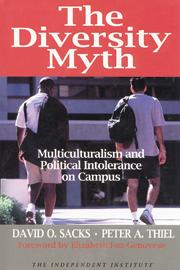The Campus culture wars continue to generate significant heat and friction, even when it seems the participants have forgotten what they were arguing about.
On the one hand are controversies surrounding “multiculturalism,” which liberal supporters claim promotes diversity, but which conservative critics denounce for eroding the common ground on which the community must stand. On the other hand are the debates over speech codes and “political correctness,” where it is liberals who defend the need for community standards, and conservatives who take the side of individual expression. Is there not a contradiction when liberal universities promote both excessive difference (multiculturalism) and stultifying conformity (PC)?
Much of this confusion stems from the inherent contradictions in the term “multiculturalism”. At an elementary level, it determines what kinds of distinctions are important, divides people into groups, defines groups according to these criteria, and suggestions how these various groups should interact. The divisions between all of these different groups are predicated upon a consensus regarding the propriety of these divisions. For multiculturalism to work, a large majority) of people must agree on what kinds of diversity should count for how much.
If asked to define multiculturalism, an articulate supporter would probably respond thusly-multiculturalism represents a bold attempt at dealing with the changing nature of American society. Whereas the America of the nineteenth and early twentieth centuries was overwhelmingly white, European, and Judeo-Christian, the America of the future will become increasingly multiracial, multiethnic, multilingual, multireligious. In the earlier America, each new wave of immigrants integrated into society by submerging its identity in the “melting pot.” While such attempts were only partially successful in the past (as many distinct American subcultures have retained aspects of their identity), such attempts will prove utterly inadequate in the future. It will not be possible to impose a “monocultural” standard on all people in the United States, as there will be too many individuals for whom such a standard would be unacceptable. Harmonious relations will depend upon knowing about other cultures and accepting them on their own terms.
This characterization of multiculturalism is attractive because its conclusions appear to follow from objective demographic facts. It seems incontrovertible that America’s ethnic makeup is changing and will continue to change dramatically in the twenty-first century.
Nevertheless, none of these demographic “facts” translates easily into multicultural policies-especially in the academy. It is certainly possible and may be desirable to study some books from non-Western cultures. But a truly relativistic reading list is impossible. At some point, criteria must be imposed to determine which books from which cultures are read. These judgments, naturally, are imposed upon all cultures which offer competing criteria.
Multiculturalists claim to solve this problem with “proportional representation,” a criterion seemingly based on objective demographic facts, rather than subjective judgments. Each culture (or, in the American context, each ethnic or gender group) should be studied in proportion to its numbers. Each group, in turn, should be allowed to choose its own great works. On the surface, the rhetoric appears to have a degree of internal logic. Knowledge of other languages, after all, is essential to in-depth understanding of a different culture, since many of the words, phrases, and books that fully describe a culture’s understanding of itself are not entirely translatable.
Remarkably, however, multicultural leaders have made clear that these common sense answers are not what they have in mind. At Stanford University, which may be the place where the phenomenon started, “multiculturalism” has next to nothing to do with a thorough study of other cultures. During the 1980s, at the same time that the university began heavily funding multicultural programming and created an Office for Multicultural Development (OMD) to oversee the university’s “transformation,” Stanford sharply decreased the number of staff in its language departments and closed several of its over-seas campuses.
These cuts proceeded without student protest and certainly without activists marching in favor of new language requirements. Rather, campus activists have advanced a vast array of causes in the name of “multiculturalism.” During just one month at Stanford, the OMD cosponsored a campus talk by Rigoberta Menchu, a Guatemalan revolutionary entitled “500 years of Oppression.” It helped draft a controversial new policy on sexual harassment, which concluded that “psychological coercion” (a euphemism for verbal seduction) might be equivalent to rape. It established the Faculty Incentive Fund to give financial bonuses to departments meeting racial quotas in hiring. It orchestrated a boycott of grapes in solidarity with a local farmers’ union, which was enforced with the help of Casa Zapata, one of the multicultural dormitories. And it banned the use of cardboard axes at Stanford football’s annual “Big Game,” because the symbol might be offensive to Native Americans and therefore incompatible with multiculturalism.
More than an empty buzzword, “multiculturalism” determined proper etiquette at football games, the need for affirmative action, the definition of rape, the reasons why grapes are banned at Stanford, and why a Guatemalan revolutionary is invited to give a campus talk. Clearly, multiculturalism has a meaning, even if it remains unspoken.
If there exists a common thread running through the multicultural maze, it appears to be that most of the multicultural faculty and administrators were student activists in the late 1960s, and many of the multicultural students emulate their role models from the earlier wave of protests. Stanford Professor Barry Katz summarized the attitudes of the multicultural generation:
“We felt-and I say we because I was of that somewhat rebellious generation myself—we felt like we needed systems of thought that would help us answer what seemed to us then to be very critical questions: Why were U.S. troops in Vietnam? Why were the urban ghettos in America blowing up every summer, and for that matter, why were there ghettos in the first place? Why was the American power structure so uniformly white, male, old, and rich? And just to make sure that nobody took these questions personally, we set fire to a few police cars and occupied a few administration buildings, shut down a couple of dozen universities, and things like that.”
The multicultural revolution is contingent on the widespread agreement on an underlying system of values by faculty and administrators. Indeed, when the values of 1960s radicals are used to define the proper parameters, multiculturalism is transformed into a comprehensive and detailed worldview. In a 1989 survey of faculty politics at colleges and universities across the county, for example, the Carnegie Foundation for the Advancement of Teaching found that seventy percent of professors identified themselves as liberal or moderately liberal, twelve to fifteen percent as moderately conservative, and only three or four percent as conservative. The single demographic fact most significant to multiculturalism may be that the professoriate of today’s academies are almost uniformly on the left of the political spectrum.
Of course, the primary value of “multiculturalism” for its advocates is precisely that it appears not to be a radical political program. It appears as something quite different—a neutral theory that describes groups of people, the decision making within these groups, the interaction between these groups, and the possibilities for special insights by some groups. The multicultural rhetoric of “diversity” and “pluralism” is not unimportant, because it serves the critical function of deflecting attention from the underlying value judgments. This obscuring of the real issues allows advocates to avoid the accusation that they are promoting a “politically correct” ideology—and even positions them on the side of “diversity” and “tolerance.”
On America’s college campuses, political activists have used the multicultural vehicle to effect sweeping change. From the curriculum to extracurricular life, from faculty hiring to student admissions, from speech codes to long-range planning, the ambiguities of “diversity” have been resolved in favor of radical policy objectives.
At bottom, multiculturalism is a symptom of the retreat of the 1960s left, of its unwillingness or inability to participate in the marketplace of ideas that is the hallmark of a successful university and of a healthy society. In the final analysis, multiculturalism does not represent a new and an innovative policy option, but rather the last gasp of a dying system of beliefs.








